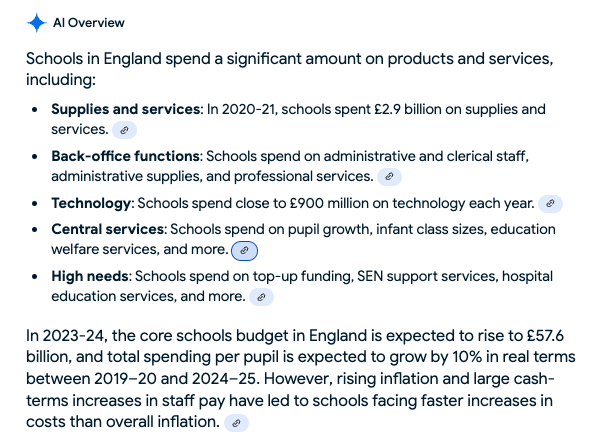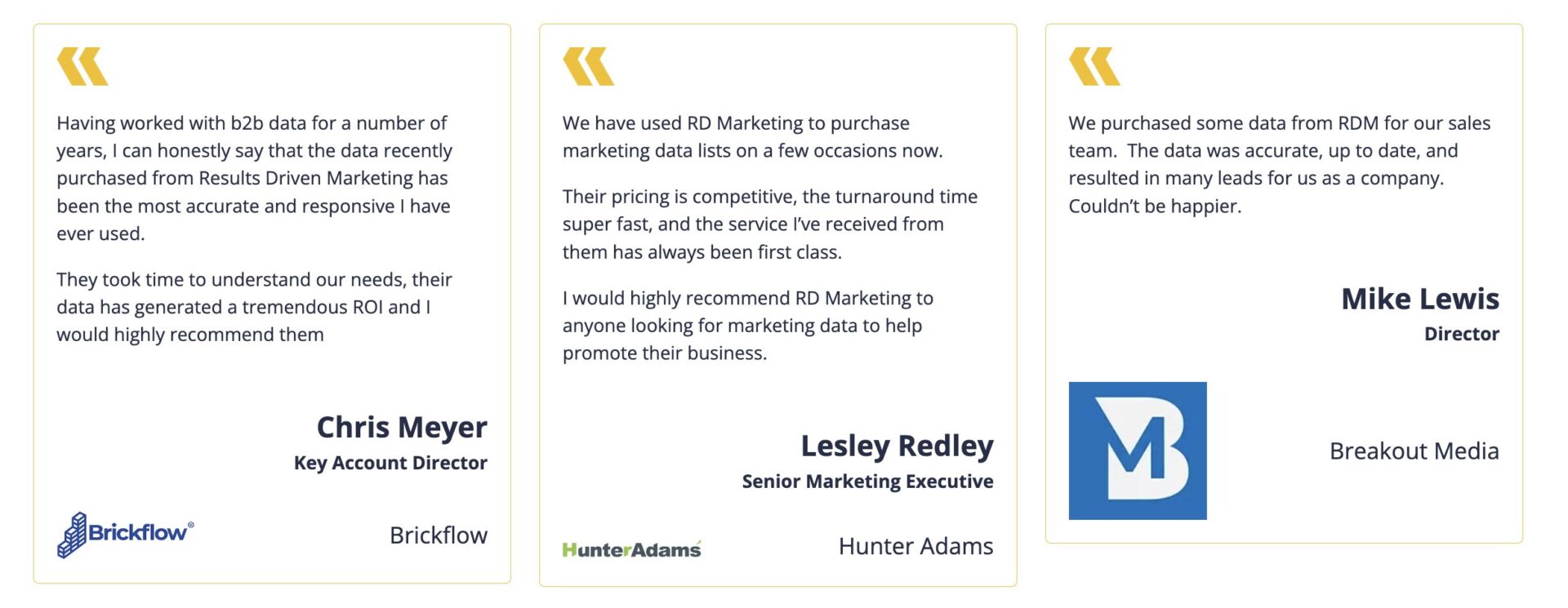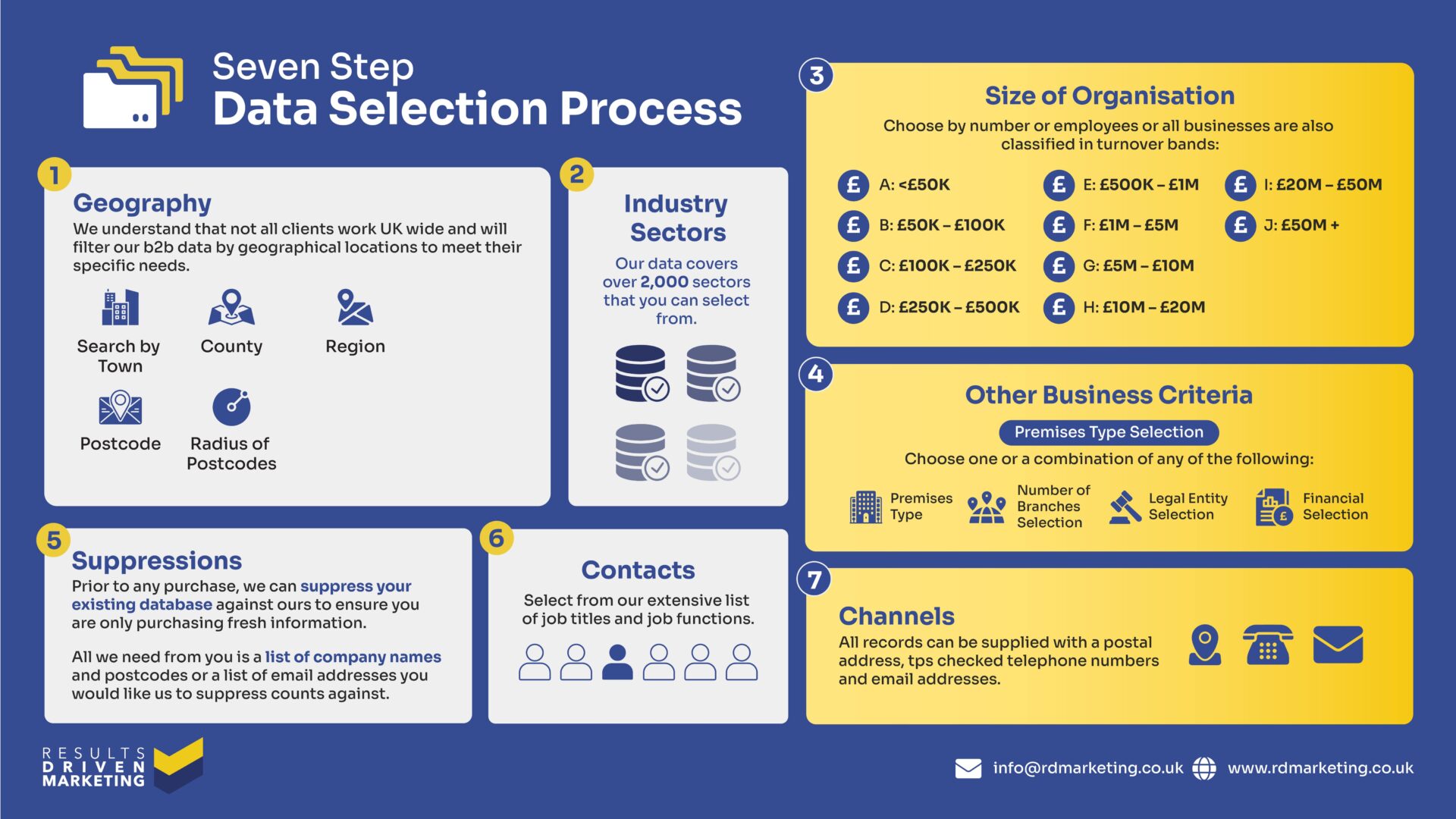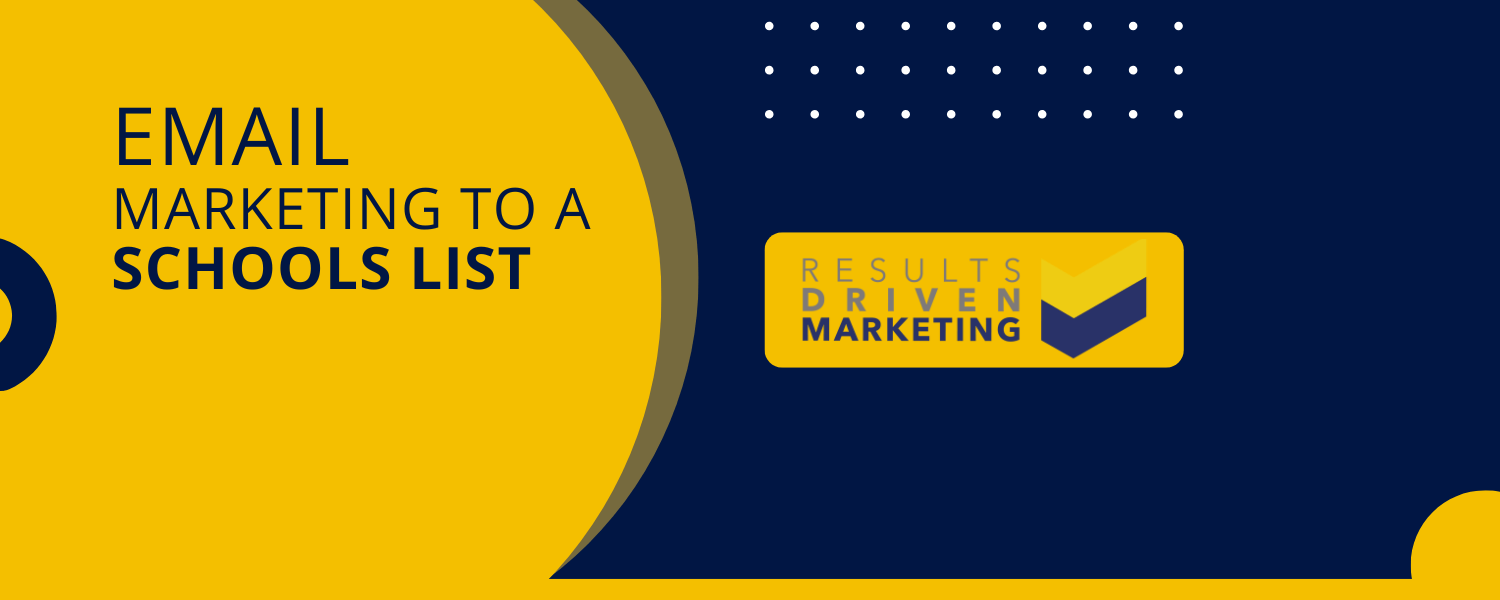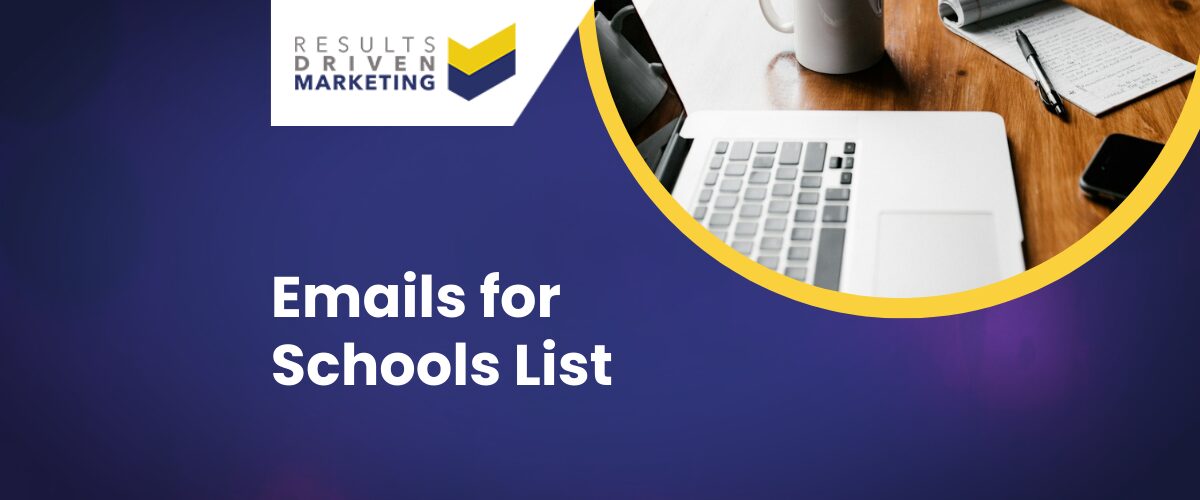
Emails for Schools List for Targeted Education Marketing
If you’re thinking about emailing schools to promote your products or services, you’re definitely on the right track. Email marketing remains one of the most direct and cost-effective ways to reach decision-makers in the education sector—whether you’re selling classroom tech, facility services, or learning tools.
But here’s the thing: success in this space comes down to data quality. Without a clean, accurate schools email list, you could end up wasting time, budget, and effort. That’s where we come in.
At RD Marketing, we help businesses run smart, targeted campaigns using GDPR-compliant and regularly updated education data. Whether you’re looking for email address list data to reach headteachers, or direct mail data for school administrators, we’ve got you covered.
Our clients use our data to launch multi-channel campaigns across email, phone, and post—so if you’re also considering telemarketing, our B2B telemarketing data can support that too.
The truth is, emailing schools can unlock huge opportunities—if you’re targeting the right people, at the right time, with the right message. And that all starts with the right data.
Table of contents:
Why Buy an Emails for Schools List?
Investing in an emails for schools list is a smart way to connect directly with key decision-makers in the education sector. Whether you’re marketing educational products, services, or solutions, having a targeted list allows you to streamline your outreach and maximise your results. Here’s why purchasing an emails for schools list can benefit your business:
1. Direct Access to Key Contacts
An emails for schools list provides accurate and verified contact details for school administrators, teachers, and decision-makers. This ensures your message reaches those responsible for purchasing and implementation decisions.
2. Save Time and Boost Efficiency
Building a contact list for schools manually can be time-consuming. With a pre-curated emails for schools list, you can save valuable time and focus on crafting compelling campaigns instead of sourcing data.
3. Tailor Your Campaigns
Schools have unique needs, and an emails for schools list allows you to segment your audience by criteria such as school type (primary, secondary, or higher education), location, or specific roles. This ensures your messaging resonates with the right people.
4. Increase ROI
Targeted campaigns are more likely to generate leads and drive conversions. An emails for schools list helps you focus your efforts, reducing waste and improving your return on investment.
5. GDPR-Compliant and Reliable Data
Reputable emails for schools lists are GDPR-compliant, ensuring your campaigns adhere to legal standards while maintaining trust with your audience.
Whether you’re promoting new classroom technologies, educational programs, or school supplies, an emails for schools list is an essential tool for reaching the right contacts efficiently and effectively. It’s the key to driving growth in the competitive education sector.
Why Marketing Products and Services to Schools Is a Big Opportunity
The education sector offers a significant and often overlooked market for businesses, making emails for schools a powerful tool for targeted marketing. With thousands of schools across the UK, each with unique needs and budgets, the opportunities for businesses to provide value are immense.
1. Diverse Needs Across Education Levels
Schools require a wide range of products and services, from classroom supplies and learning technologies to facility management and training programs. Whether you target primary schools, secondary schools, or higher education institutions, the demand for innovative and efficient solutions is constant.
2. Decision-Making by Committees
Many schools rely on decision-making by multiple stakeholders, such as teachers, administrators, and procurement managers. Accessing a list of emails for schools allows you to connect directly with these individuals, ensuring your message reaches those who can act on it.
3. Recurring Budgets and Long-Term Relationships
Schools operate on annual budgets, meaning they regularly review and allocate funding for products and services. This creates opportunities for recurring sales and the potential to build long-term relationships.
4. A Growing Focus on Innovation
As education evolves, schools are increasingly looking for innovative tools to improve learning outcomes and operational efficiency. Businesses offering cutting-edge technologies, digital resources, or sustainability solutions are well-positioned to meet these needs.
5. Broad Market Potential
With a targeted emails for schools list, businesses can expand their reach to public and private schools, academies, and special education facilities. This breadth of opportunity makes the education sector one of the most versatile markets to tap into.
By marketing to schools, businesses can not only achieve growth but also make a meaningful impact on education. A well-targeted emails for schools list is your gateway to seizing these opportunities and becoming a trusted partner in the education industry.
How many records does our Email Addresses for Schools List contain?
At the time of writing (we operate from a live database)…
The Email Addresses for Schools List UK contains contact information for over 50,000 contacts within education establishments across the UK.
| Code | Description | Total |
| EA118 | Colleges – Technical & Agricultural | 14 |
| EA145 | Educational Services | 3374 |
| EA146 | Educational Training Providers | 477 |
| EA157 | Language Schools | 722 |
| EA172 | Nurseries & Creches | 6288 |
| EA175 | Nursery Schools | 1611 |
| EA178 | Playgroups & Pre-School Education | 6100 |
| EA180 | Organised Childrens Play Schemes | 131 |
| EA187 | Schools Excl Independent & Special | 1281 |
| EA189 | Schools – Foundation | 5658 |
| EA190 | Schools – Independent & Preparatory | 1022 |
| EA199 | Schools – Primary | 18523 |
| EA202 | Schools – Middle | 473 |
| EA205 | Schools – Secondary | 1870 |
| EA214 | Schools – Special | 1375 |
| EA217 | Schools – Sports & Leisure Activities | 60 |
| EA220 | Schools & Colleges – Art & Design | 73 |
| EA223 | Schools & Colleges – Commercial | 17 |
| EA226 | Schools & Colleges – Further Education | 1361 |
| EA244 | Universities & Medical Schools | 642 |
| Total | 51072 |
What does a record on our Emails for Schools List contain?
Each record can come complete with:
- Company name
- Full postal address
- Contact name
- Direct email address
- TPS checked telephone number
- Industry sector
- Number of employees
- Company turnover
Our data accuracy guarantee
The emails of schools list is guaranteed accurate to industry high standards:
- 98% postal address accuracy
- 95% telephone number and contact name accuracy
- 95% email address accuracy
Should we fall below any of the above minimum benchmarks, we offer a like for like replacement service of pro-rata refund.
This provides total peace of mind to businesses ordering for the first time.
Here’s some examples of clients we have benefited from our Emails for Schools List?
How much does the Emails for Schools List cost?
The answer is…
It depends!
Like most things, the more you buy, the cheaper it gets.
Give us a call today and we will craft a totally bespoke for you.
Can our Emails for Schools Mailing List UK be filtered?
Absolutely. We understand that no two customers the same and encourage each to discuss their individual needs with us.
Our consultants are more than happy to talk you through we can go about making this meet your specific markets, exactly.
Boost your campaigns with our email marketing solutions
Run in-house campaigns with Responder
If you’re ready to take control of your email marketing efforts, our email platform, Responder, is the perfect solution. Designed for businesses using a list of schools emails, Responder lets you send targeted campaigns directly to key decision-makers within the property industry.
Here’s why Responder stands out:
- Accepts all email lists: Whether you’re using our high-quality emails for schools list or your own data, Responder makes it simple to upload and start sending.
- Cost-effective: With affordable pricing plans, it’s the ideal choice for businesses looking to maximise ROI without breaking the bank.
- User-friendly Interface: You don’t need to be a tech expert—Responder is intuitive and easy to navigate, even for beginners.
- Full support provided: Our team is on hand to assist with setup, troubleshooting, and best practices, ensuring your campaigns run smoothly from start to finish.
Let us handle the work with our managed campaign services
Our Managed Email Marketing Campaign Services are here to help. We’ll handle every aspect of your email campaigns, allowing you to focus on other areas of your business while we deliver exceptional results.
Our managed service includes:
- Bespoke HTML email design: We’ll create a stunning, brand-aligned email that captures attention and engages your audience.
- Broadcast management: From scheduling to delivery, we’ll ensure your emails reach the inbox of schools at the perfect time.
- Performance Optimisation: Our team continuously monitors and refines campaigns to ensure the best possible outcomes.
Whether you want to take charge with Responder or let our experts handle it all, we have the tools and services to make your email marketing campaigns to schools a success.
Emails for Schools List FAQ’s
Where does our Emails for Schools List for Emailing Schools originate?
We work with the UK’s leading data aggregator who have been voted b2b data supplier of the year for a record five times.
Established for over thirty years, they take the very best parts of the top five data houses in the UK to compile their master file of over 3.25 million records, which we supply from.
Is the Email Address for Schools Mailing List GDPR Compliant?
Compliance is something that we place massive importance on. We wouldn’t be able to stand by our company ethos of only supplying the best b2b data available if we didn’t.
If you have any concerns with regards the compliancy of our Database of UK Schools or any of our b2b data solutions, feel free to call us on 0191 406 6399 and speak to us directly.
What licence terms are offered on the Emails for Schools List when emailing for Schools?
All our b2b data is made available on a 12 month multi-use licence which means you can use it as much as you like.
What format does the the Emails for Schools Mailing List UK come in?
Our b2b data is sent you via secure email transfer in either Excel or .csv format.
Email Marketing to A Schools List
What Are the Advantages of Email Marketing to Your Emails for Schools?
Email marketing has become a cornerstone of effective communication with schools. Whether you’re promoting educational tools, workshops, or services tailored for the education sector, email campaigns offer unparalleled benefits that make them the go-to choice for marketers.
Cost-Effectiveness Compared to Traditional Marketing Methods
Email marketing is far more budget-friendly than traditional methods like direct mail or print ads. It eliminates the need for physical materials, postage, and distribution, allowing you to allocate more resources to crafting compelling messages. With tools like Email Marketing Management Services, you can streamline your campaigns without overspending.
Direct Access to Decision-Makers
One of the greatest advantages of email marketing is its ability to connect you directly with the people who make decisions in schools—principals, administrators, and department heads. Using targeted B2B Data or Email Address List Data, you can ensure your message reaches the right audience at the right time, avoiding the noise of less focused marketing channels.
Measurability of Campaign Results
With email marketing, you can track every aspect of your campaign. Metrics like open rates, click-through rates, and conversions give you a clear picture of performance. For instance, integrating your campaigns with a tool like Data Enrichment Services can enhance your ability to analyse and refine your strategy over time.
Scalability for Campaigns of Any Size
Whether you’re targeting a small group of local schools or launching a national campaign, email marketing scales effortlessly. Start with a Direct Mail Data campaign for a personal touch, and then extend your outreach through tailored email messages to maximise impact.
Opportunities for Personalisation
Personalised emails perform significantly better than generic ones. Addressing recipients by name, referencing their school, or tailoring content to their needs can dramatically improve engagement. With tools like CTPS Checker, you can ensure compliance while delivering messages that resonate.
Is Email Marketing to Your Emails for Schools a Good Idea?
Email marketing is one of the most effective strategies for engaging with schools. However, like any marketing method, its success depends on how well it is planned and executed. Let’s explore the key scenarios where email marketing truly shines and the challenges you might face along the way.
Scenarios Where Email Marketing Excels
Promoting Educational Tools and Resources
Schools are always on the lookout for innovative solutions to enhance learning experiences. Email campaigns allow you to showcase educational tools, software, and resources directly to the decision-makers. With targeted B2B Data or an International Email List, you can ensure that your message reaches schools that are actively seeking your offerings.
Offering Teacher Training or Professional Development Programs
Teachers and administrators often look for training opportunities to stay ahead in their careers. Email marketing can help you promote workshops, webinars, or certification programs tailored to educators. A clean and up-to-date Email Address List Data ensures your message gets delivered to the right recipients without any barriers.
Announcing Events Like Workshops, Seminars, or Conferences
Whether it’s an in-person seminar or a virtual conference, email marketing can generate awareness and drive registrations. Use an engaging subject line and include clear CTAs to encourage immediate responses. Services like Email Marketing Management can help you manage and optimise these campaigns seamlessly.
Potential Challenges to Consider
Compliance with Privacy Regulations
One of the most critical aspects of email marketing is adhering to data privacy laws like GDPR. Schools are highly conscious of privacy and security, making compliance even more important. Utilising tools like the CTPS Checker ensures that your email lists comply with all necessary regulations.
Avoiding Spam Filters
No matter how compelling your message is, it won’t matter if it lands in the spam folder. Use professional services such as Data Cleansing Services to maintain a high-quality email list and reduce bounce rates.
Crafting Relevant Content
Generic emails rarely work when marketing to schools. Instead, focus on creating tailored content that speaks directly to the needs of educators and administrators. Start by segmenting your list using tools like Data Enrichment Services for deeper insights into your audience.
What Are the Key Considerations When Email Marketing to Your Emails for Schools?
When it comes to email marketing for schools, careful planning and attention to detail are essential for a successful campaign. Here are the key factors to keep in mind when targeting your Emails for Schools:
Ensuring Data Accuracy in Your Emails for Schools List
The foundation of any email marketing campaign is an accurate and up-to-date email list. Schools regularly change staff, email addresses, and contact details, so it’s crucial to keep your database refreshed. Using services like Data Cleansing Services ensures your Emails for Schools list is reliable and free of invalid addresses. This step not only boosts deliverability but also improves the overall performance of your campaigns.
Compliance with Data Protection Regulations, Like GDPR or CAN-SPAM
Privacy laws such as GDPR and CAN-SPAM are designed to protect recipients from unsolicited or irrelevant emails. When targeting schools, adhering to these regulations is non-negotiable. Use tools like the CTPS Checker to verify your email lists for compliance. Additionally, always include clear unsubscribe options and ensure your content respects recipients’ privacy.
Crafting Content Relevant to the Needs of Schools
Generic messaging rarely resonates with schools. Instead, focus on creating content tailored to their specific challenges and goals. For example:
- Highlight solutions for enhancing classroom learning.
- Promote tools that simplify administrative tasks.
- Offer professional development opportunities for teachers.
Leverage insights from Data Enrichment Services to better understand your audience and deliver content that meets their expectations.
Timing Emails to Align with Academic Calendars
Timing is everything when marketing to schools. Campaigns sent during busy periods, such as exam seasons or holidays, are more likely to be overlooked. Instead:
Research the academic calendar for your target schools.
Schedule campaigns for quieter times, such as the beginning of the term or planning periods.
By aligning your efforts with their schedule, you increase the chances of engagement. Using Email Marketing Management Services can help automate your campaigns for precise timing.
What Are the Benefits of Email Marketing to Your Emails for Schools?
Email marketing offers a wide range of benefits that make it an ideal communication tool for connecting with schools. Here’s how it can help you achieve your goals while fostering meaningful relationships with the education sector.
Efficiency in Communication with Multiple Stakeholders
Email marketing provides a streamlined approach to reaching various stakeholders in schools, such as principals, administrators, and teachers, all in one go. This efficiency saves time and ensures consistent messaging. By utilising Email Address List Data or a curated International Email List, you can tailor your campaigns to meet the specific needs of each group.
Instead of relying on time-consuming methods like direct mail or phone calls, email allows you to communicate faster and more effectively, ensuring no opportunity is missed.
Improves Engagement and Fosters Long-Term Relationships
Building relationships with schools takes time, and email marketing serves as the perfect channel for nurturing these connections. Regular, targeted campaigns keep your brand top of mind for educators and decision-makers.
For instance, sending updates about new educational tools, workshops, or exclusive offers can significantly enhance engagement. Services like Data Enrichment Services allow you to personalise your emails further, making your audience feel valued and understood. Personalisation, in turn, leads to higher open rates and stronger relationships over time.
Supports Other Channels Like Social Media
Email marketing doesn’t work in isolation—it’s a powerful way to drive traffic to other channels, such as social media. By including links to your social platforms in your campaigns, you encourage schools to explore your broader offerings.
For example:
- Promote a webinar by embedding a registration link in your email.
- Drive traffic to a blog or resource page on your website.
- Encourage schools to follow your social media pages for daily updates.
Combining email campaigns with services like Email Marketing Management and Telemarketing Data ensures your message reaches your audience from multiple angles, amplifying its impact.
Email Marketing Best Practices to Your Emails for Schools
When it comes to email marketing, following proven best practices ensures that your campaigns are both impactful and engaging. Here’s how to make your Emails for Schools campaign stand out and deliver results.
Segmenting Your Audience for Tailored Content
Not all schools are the same, and their needs can vary significantly. That’s where segmentation comes into play. By categorising your Emails for Schools list into specific groups—such as primary schools, secondary schools, or administrative roles—you can craft messages that resonate with each audience.
Using tools like Data Enrichment Services allows you to dive deeper into the specifics of your audience, ensuring that your content is highly relevant. Segmentation not only increases open rates but also enhances engagement and conversion rates by speaking directly to the needs of your recipients.
Ensuring Mobile-Friendly Email Design
With the majority of users checking their emails on mobile devices, ensuring your Emails for Schools are mobile-optimised is no longer optional—it’s essential. Follow these tips for mobile-friendly design:
- Use a single-column layout for easier readability.
- Keep subject lines concise to display properly on smaller screens.
- Optimise images to load quickly without compromising quality.
By leveraging Email Marketing Management Services, you can test and refine your email designs to ensure they perform well across devices.
Testing Subject Lines, Email Formats, and Content for Effectiveness
A/B testing is a game-changer when it comes to refining your email marketing strategy. Experiment with different elements of your emails, such as:
Subject lines—Test variations like questions, personalisation, or urgency.
Email formats—Try plain-text emails versus visually rich templates.
Content—Adjust tone, call-to-action placement, or overall length.
Analysing the results helps you determine what works best for your Emails for Schools campaigns. Regular testing using services like Data Cleansing Services ensures that your campaigns are always improving and staying relevant.
Using Clear, Actionable CTAs
A compelling call-to-action (CTA) is the cornerstone of every successful email campaign. When crafting CTAs for your Emails for Schools, keep the following in mind:
- Use action-oriented language like “Register Now,” “Download the Guide,” or “Sign Up Today.”
- Place the CTA prominently in your email, ensuring it’s easy to find.
- Make the CTA visually distinct using buttons or contrasting colors.
By incorporating strong CTAs into your campaigns, you guide your audience toward the next step, whether it’s visiting your website or registering for an event. Tools like CTPS Checker help maintain compliance while optimising deliverability.
How to A/B Split Test Email Marketing Campaigns to Your Emails for Schools
A/B split testing is one of the most effective ways to fine-tune your email marketing campaigns to your Emails for Schools. By systematically testing different variables, you can discover what resonates most with your audience and optimise your campaigns for better performance.
What is A/B Testing and Why is It Important?
A/B testing involves creating two or more variations of an email and sending them to different segments of your Emails for Schools audience. The goal is to identify which version performs better based on metrics like open rates, click-through rates, or conversions.
For example:
- Does a subject line with a question engage more than a direct statement?
- Does a brightly colored CTA button drive more clicks than a subtle one?
By answering these questions through A/B testing, you can refine your strategy and create campaigns that consistently deliver results. Tools like Email Marketing Management Services can make this process seamless and efficient.
How to Test Variables in Your Emails for Schools Campaigns
Subject Lines
The subject line is the first thing recipients see, so testing different approaches can significantly impact open rates. Examples include:
Personalised subject lines (e.g., “Hi [First Name], Are You Ready for This?”).
Action-driven phrases (e.g., “Sign Up Today for Exclusive School Resources”).
Informative vs. intriguing tones (e.g., “Upcoming Training Sessions for Teachers” vs. “Unlock Your Free Training Today”).
CTA Placement and Wording
Your call-to-action (CTA) guides recipients to take the desired next step, making it a critical component to test.
Placement: Test if CTAs perform better above the fold, in the middle, or at the end of the email.
Wording: Experiment with action-oriented phrases like “Learn More,” “Join Now,” or “Get Started Today.”
Design: Compare buttons versus hyperlinked text to see which garners more clicks.
Email Copy and Layout
Your email content and structure directly impact engagement. A/B testing can include:
Long-form vs. short-form emails: Test if detailed descriptions or concise bullet points work better.
Visual elements: Evaluate the impact of images, infographics, or plain text.
Tone: Try a formal tone for administrators versus a conversational one for teachers.
Steps to Analyse Results and Iterate
Define Success Metrics
Decide what you want to measure—open rates, click-through rates, conversions, or another KPI.
Run Controlled Tests
Send each variation of your email to a small segment of your Emails for Schools list. Ensure the audience groups are similar to maintain accuracy.
Analyse Performance
Review the results to identify clear winners. Did one subject line outperform another? Was a specific CTA more effective?
Implement Changes and Test Again
Apply the winning elements to your next campaign and continue testing other variables to improve results further. Regular refinement is key to staying effective.
How to Measure Email Marketing Campaign Results to Your Emails for Schools
Measuring the success of your email marketing campaigns to your Emails for Schools is essential to understanding what works and where improvements can be made. By tracking key metrics, using the right tools, and setting clear benchmarks, you can ensure your campaigns are effective and deliver the desired results.
Key Metrics to Track
Open Rates
Open rates indicate how many recipients opened your email. A high open rate often reflects a compelling subject line or sender name. If open rates are lower than expected, consider testing personalised subject lines or ensuring your Emails for Schools list is clean and accurate using Data Cleansing Services.
Click-Through Rates
Click-through rates measure how many recipients clicked on links within your email. This metric helps you gauge the effectiveness of your content and call-to-actions (CTAs). To improve this, try experimenting with CTA wording, placement, and design using insights from Email Marketing Management Services.
Conversion Rates
The ultimate measure of success is how many recipients completed the desired action, whether that’s registering for an event, downloading a resource, or making a purchase. Use a targeted Email Address List Data to ensure you’re reaching the right audience and driving meaningful results.
Tools for Tracking and Analysis
Investing in the right tools can simplify the process of measuring campaign performance. Platforms offering comprehensive analytics help you monitor:
- Engagement metrics (open rates, click-through rates).
- Audience behavior (time spent on emails, links clicked).
Using services like Data Enrichment Services allows you to gain deeper insights into your audience, making it easier to tailor future campaigns.
Setting Benchmarks to Evaluate Success
Define Goals Before Launching the Campaign
Identify what you want to achieve—whether it’s increasing attendance at a seminar, driving traffic to your website, or building awareness about your brand.
Use Industry Standards for Comparison
Compare your metrics to industry benchmarks for education-focused campaigns. For example:
Average open rates for Emails for Schools.
Standard click-through rates for similar campaigns.
Iterate Based on Performance
Review your results regularly and identify areas for improvement. For instance:
If open rates are low, revisit your subject lines or test different send times.
If click-through rates are below average, experiment with content layout and CTAs.
How to Craft Email Marketing CTAs to Your Emails for Schools
Crafting compelling calls-to-action (CTAs) is an essential part of creating successful email marketing campaigns for your Emails for Schools. CTAs guide your audience to take the next step, whether that’s downloading a resource, signing up for an event, or exploring your website. Let’s explore how to make your CTAs concise, engaging, and effective.
The Importance of Concise and Actionable CTAs
A well-crafted CTA is direct, clear, and encourages immediate action. Overcomplicated CTAs can confuse readers and reduce engagement. Instead, aim for CTAs that:
- Use simple and actionable language like “Register Now” or “Learn More.”
- Focus on a single, specific action to avoid overwhelming the recipient.
- Create urgency when appropriate, such as “Limited Spots Available—Sign Up Today!”
By keeping your CTAs concise and actionable, you make it easier for your Emails for Schools recipients to respond quickly.
Examples of CTAs Tailored for Schools
When targeting schools, your CTAs should align with their interests and priorities. Here are a few examples:
For Resources and Guides:
“Download the Free Lesson Plan Guide.”
“Access Your Classroom Management Toolkit.”
For Events and Workshops:
“Register for the Professional Development Webinar.”
“Save Your Spot for the School Leaders Conference.”
For Products and Services:
“Explore Our Learning Management Platform.”
“Request a Demo of Our Teacher Training Software.”
By personalising CTAs based on your audience’s needs, you enhance the likelihood of engagement. Use tools like Data Enrichment Services to gain deeper insights into your audience and craft CTAs that resonate.
Placement Strategies to Maximise Engagement
Where you place your CTAs within your Emails for Schools can greatly impact their effectiveness. Consider the following strategies:
- Above the Fold: Ensure your primary CTA is visible without scrolling for maximum visibility.
- Within Context: Place CTAs directly after discussing a relevant topic or benefit to make the action feel natural.
- At the End: Include a final CTA to reinforce the message and provide a clear next step.
Additionally, experiment with buttons versus text links to see which format generates better results. Services like Email Marketing Management Services can help you test and optimise CTA placement over time.
How to Craft Email Marketing Subject Lines to Your Emails for Schools
Creating the perfect subject line is crucial for capturing attention and encouraging recipients to open your emails. Your subject line is often the first impression you make, so it needs to be engaging, relevant, and compelling. Here’s how to craft attention-grabbing subject lines for your Emails for Schools campaigns.
Tips for Creating Attention-Grabbing Subject Lines
To ensure your subject lines catch the eye, follow these best practices:
Keep It Short and Sweet: Aim for fewer than 50 characters to ensure readability across devices.
Use Numbers and Lists: Subject lines like “5 Tips for Smarter Classroom Management” can draw attention.
Pose a Question: Engaging questions like “Is Your School Ready for the Next Step in Digital Learning?” pique curiosity.
Highlight Benefits: Focus on the value recipients will get, such as “Save Time with Our Free Lesson Planning Guide.”
Experiment with subject lines using A/B testing to discover what resonates best with your audience. Tools like Email Marketing Management Services can streamline this process.
Using Personalisation and Urgency
Adding a touch of personalisation or urgency can dramatically improve open rates. Consider these strategies:
- Personalisation: Include the recipient’s name, school name, or a specific role (e.g., “Hi [Name], Ready to Enhance Your Students’ Learning Experience?”).
- Urgency: Create a sense of time sensitivity, such as “Last Chance to Register for Our Workshop!” or “Offer Ends Tomorrow—Don’t Miss Out!”
- Relevance: Reference something specific to their needs, like “Discover Resources Designed for Primary Schools.”
Utilise Data Enrichment Services to gather deeper insights into your audience, enabling even more tailored subject lines.
Avoiding Spam-Triggering Words
Spam filters are designed to protect recipients from unwanted emails, but they can also block legitimate ones. Avoid common spam triggers by:
- Steering clear of overly promotional language like “Free,” “Earn Money,” or “Act Now.”
- Balancing punctuation—avoid excessive exclamation marks or all-caps text.
- Maintaining transparency by aligning the subject line with the email content.
By using a clean Email Address List Data and incorporating compliance checks with tools like the CTPS Checker, you can reduce the risk of emails being flagged as spam.
How to Measure the ROI of Email Marketing Campaigns to Your Emails for Schools
Measuring the return on investment (ROI) of your email marketing campaigns to your Emails for Schools is essential to understand their effectiveness and justify your marketing spend. By analysing both immediate and long-term results, you can optimise your strategies and maximise the impact of your efforts.
What Is ROI and Why Is It Important?
ROI, or Return on Investment, is a metric used to evaluate the profitability of your marketing campaigns. It answers a simple but critical question: Are your efforts generating more value than they cost? For email campaigns to your Emails for Schools, ROI helps you determine:
- Which campaigns yield the best results.
- How to allocate your budget effectively.
- The overall impact on your organisation’s goals.
By consistently measuring ROI, you can make informed decisions that enhance the performance of your campaigns. Services like Email Marketing Management Services can assist in tracking and calculating ROI efficiently.
Steps to Calculate ROI
Total Revenue Generated vs. Campaign Costs
Start by calculating the total revenue generated directly from your Emails for Schools campaigns. This includes registrations, purchases, or donations attributable to the emails. Next, subtract the total campaign costs, including:
- Email software or platform fees.
- Data acquisition from sources like Email Address List Data.
- Design, content creation, and other associated expenses.
Finally, use this formula to calculate ROI:
ROI=Total Revenue−Campaign CostsCampaign Costs×100ROI = \frac{\text{Total Revenue} – \text{Campaign Costs}}{\text{Campaign Costs}} \times 100For example, if a campaign generated £5,000 in revenue with a cost of £1,000, the ROI would be 400%.
Long-Term Impact on Brand Visibility
While immediate revenue is important, don’t overlook the long-term value of increased brand visibility and engagement. Consistently sending valuable content to your Emails for Schools builds trust and positions your brand as a go-to resource for educational solutions.
Measure this impact by tracking metrics such as:
Growth in email subscribers using tools like Data Cleansing Services.
Engagement rates over time.
Website traffic originating from email campaigns.
Examples of Successful ROI Calculations for Educational Campaigns
Let’s say a school-focused webinar campaign cost £2,000 to run, including:
- A Telemarketing Data purchase to target schools.
- Email design and content creation.
The campaign resulted in £10,000 in new registrations and product purchases. Using the ROI formula:
ROI=£10,000−£2,000£2,000×100=400%ROI = \frac{£10,000 – £2,000}{£2,000} \times 100 = 400\%This ROI demonstrates the profitability of the campaign and justifies future investments in similar strategies.
How to Segment Your Emails for Schools for Email Marketing Campaigns
Segmentation is a powerful way to personalise your email marketing campaigns and boost their effectiveness. By dividing your Emails for Schools list into smaller, more targeted groups, you can create tailored messages that resonate with each audience. Let’s dive into the key factors to consider and the tools that can help.
Factors to Consider When Segmenting Your Emails for Schools
School Type (Primary, Secondary, Higher Education)
Different types of schools have distinct needs. Tailor your campaigns based on the specific challenges and priorities of each type:
- Primary Schools: Focus on teaching aids, parent engagement tools, and foundational learning resources.
- Secondary Schools: Highlight tools for advanced subject learning, career preparation, and exam readiness.
- Higher Education: Showcase technology for virtual learning, campus management, and student services.
Using Email Address List Data or B2B Data can help you acquire segmented lists for precise targeting.
Geographic Location
Schools in different regions often face unique challenges based on local regulations, funding, and cultural priorities. Segmenting your Emails for Schools list by location allows you to:
- Address region-specific issues or opportunities.
- Promote events or workshops in nearby areas.
- Align your messaging with the academic calendars of various regions.
Tools like Data Enrichment Services can provide detailed insights into geographic preferences and behaviors.
Specific Roles (Teachers, Administrators, Procurement Officers)
Understanding who you’re addressing within a school is critical for crafting relevant content:
- Teachers: Focus on classroom tools, professional development, and lesson planning resources.
- Administrators: Highlight solutions for school management, staff training, and communication systems.
- Procurement Officers: Emphasise cost-effective solutions, bulk purchasing options, and compliance with procurement policies.
Segmenting by role ensures your Emails for Schools provide value to each recipient, increasing engagement and conversions.
Tools for Segmentation
Email Marketing Software
Platforms like Email Marketing Management Services enable you to segment your Emails for Schools list easily and automate targeted campaigns.
Data Cleansing and Enrichment Services
A clean and enriched database is the backbone of effective segmentation. Services like Data Cleansing Services and CTPS Checker ensure your email lists are accurate, up-to-date, and compliant.
Third-Party Data Providers
Providers like International Email List and Direct Mail Data offer ready-to-use segmented lists tailored to specific audiences.
How to Integrate Email Marketing Campaigns to Your Emails for Schools with Other Marketing Channels
Integrating email marketing campaigns into a multi-channel strategy can significantly amplify the impact of your Emails for Schools. By combining the strengths of different platforms, you can enhance engagement, reinforce messaging, and achieve better results.
Benefits of a Multi-Channel Approach
A multi-channel strategy allows you to:
- Reach a Wider Audience: Some schools might prefer social media or direct mail, while others engage more with emails. A multi-channel approach ensures no one is left out.
- Reinforce Your Message: Consistent messaging across channels makes your campaigns more memorable.
- Boost Engagement Rates: By leveraging multiple touchpoints, you increase the chances of your audience taking action.
Examples of Integration
Using Email to Drive Social Media Engagement
Emails can be a gateway to social media engagement. For example:
Include links to your social media pages in your email footer.
Promote exclusive content or contests on platforms like Instagram or Facebook through your Emails for Schools.
This approach ensures that your audience engages with your brand across different platforms, creating more opportunities for interaction.
Coordinating with Direct Mail Campaigns
Direct mail is a highly effective complement to email marketing. For instance:
Send a postcard announcing an upcoming event, followed by an email with additional details.
Use direct mail to deliver a tangible resource, then follow up with an email offering related digital materials.
Combining email with Direct Mail Data enhances your campaign’s reach and impact.
Tools for Seamless Integration
Leverage tools like Email Marketing Management Services to manage your email campaigns efficiently and integrate them with other channels. Additionally, services like Data Enrichment Services can help you create more personalised campaigns that align with your multi-channel strategy.
What Are the Alternatives to Email Marketing to Your Emails for Schools?
While email marketing is incredibly effective, it’s not the only way to engage schools. Exploring alternative strategies can diversify your outreach and strengthen your overall marketing plan.
Social Media Marketing
Social media platforms like LinkedIn and Facebook are great for connecting with educators and administrators.
- Advantages: Visual content, real-time engagement, and easy sharing.
- Challenges: Requires consistent updates and audience interaction to stay effective.
Leverage insights from B2B Data to identify the best platforms for your target audience.
Direct Mail Campaigns
Direct mail offers a tangible way to communicate with schools, often leaving a lasting impression.
- Advantages: High open rates and the ability to stand out.
- Challenges: Higher costs compared to email marketing.
Using Direct Mail Data, you can create campaigns tailored to schools’ needs.
Webinars or Virtual Events
Hosting webinars or virtual events is an excellent way to provide value and engage directly with schools.
- Advantages: Builds credibility and provides in-depth interaction.
- Challenges: Requires more planning and promotional efforts.
Combine webinar promotions with email campaigns for maximum attendance.
Other Services
Database Cleansing
One of the main responses we get from prospective clients is…
“We have been in business for x number of years and have a great database already”.
That is great news for us because we can help make it even better!
We can complete incomplete records, correct spelling errors, reformat addresses, remove obsolete data, improve legality.
Data decays annually and it is essential to maintain the accuracy of your existing database.
By using this very simple yet highly effective service we can save you money, increase responsiveness and importantly ensure legality.
Nothing breeds confidence in your campaigns more than having a clean and responsive database that generates leads.
Contact us today to find out how we can make your existing database even better.
Database Enrichment
Our data experts can drill down into your current database to identify your customers and find more of them.
We can give you a detailed description of their key attributes by location, size, and sector.
By going through this process we can save you money, generate customer profiles and create new matched contacts.
We take all the passion we have for data and apply it to your existing customer database to find more of the businesses that you could be working with.
Call us today to find out how our data experts can transform the way you buy data.
TPS Checking
The Telephone Preference Service (TPS) is an initiative started by the UK government to protect individuals from unwanted sales and marketing calls.
The service provides a register where people can sign up and indicate that they do not want to receive unsolicited calls.
This free service is a great tool for individuals who want to control the type and frequency of calls they receive.
Although the TPS is voluntary, all telemarketing companies operating in the UK are legally obliged to check their calling database against the TPS register every 28 days. Failure to do so can lead to fines of up to £500,000.
The Information Commissioner’s Office (ICO) is the regulatory body responsible for enforcing this law.
The importance of complying with the TPS regulations cannot be overemphasised. Cold calling can be a nuisance to many individuals and causes a great deal of inconvenience. People receive calls during unsuitable times, like meal times, or when they are trying to relax after a long day at work. It can also be stressful for vulnerable and elderly people who may feel pressured and intimidated.
More importantly, calling individuals who have registered with the TPS can result in serious consequences for telemarketers. Companies can face hefty fines and legal action that can be detrimental to their business reputation. Customers who feel they have been harassed by telemarketers can also lodge complaints against the company, leading to public scrutiny and negative publicity.
In conclusion, the Telephone Preference Service is a vital tool for individuals who want to control the type and frequency of calls they receive. Companies conducting cold calling must take measures to check their database against the TPS register to avoid calling registered numbers.
This not only prevents unwanted solicitations but also protects telemarketers from legal repercussions and negative publicity. Compliance with the TPS regulations is not only good for individuals but also a responsible business practice that can ultimately lead to customer satisfaction and improved reputation.
Talk to our experts today about our TPS checking services
Who are we?
Dedicated to lead generation, Results Driven Marketing provides myriad services SMEs can trust to deliver results.
Our marketing lists are guaranteed accurate to industry high standards, and GDPR compliant and our experience team means that if you are looking to buy data, they make them totally bespoke and highly relevant whether you are looking for email lists, direct mailing lists , international data or telemarketing data for the telemarketing lists
Our email marketing software and email automation software is highly rated. Responder provides the automation tools you need to put your marketing on autopilot.
We provide direct mail data, data enrichment services, data cleansing services and also supply email marketing solutions with our email marketing platform.
Have a look a what our happy clients have to say about us on our testimonials page
Call us today on 0191 406 6399 to discuss your specific needs.
Results Driven Marketing
info@rdmarketing.co.uk
Contact Us
0191 406 6399


